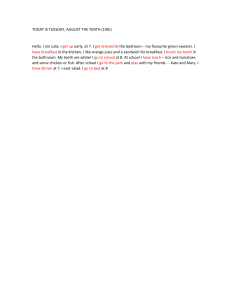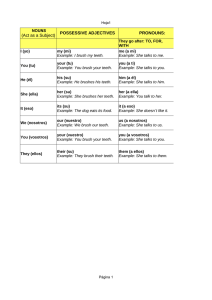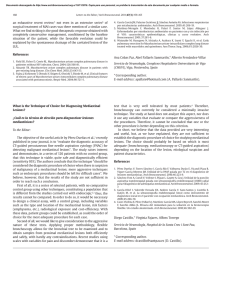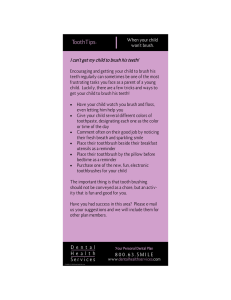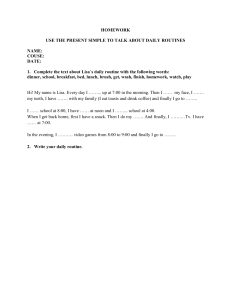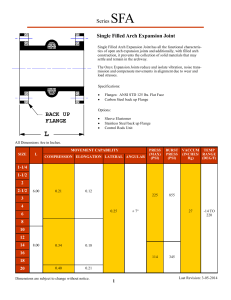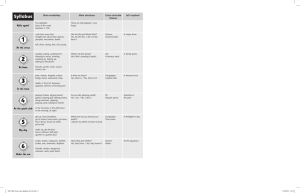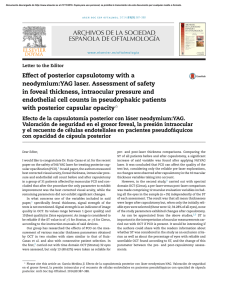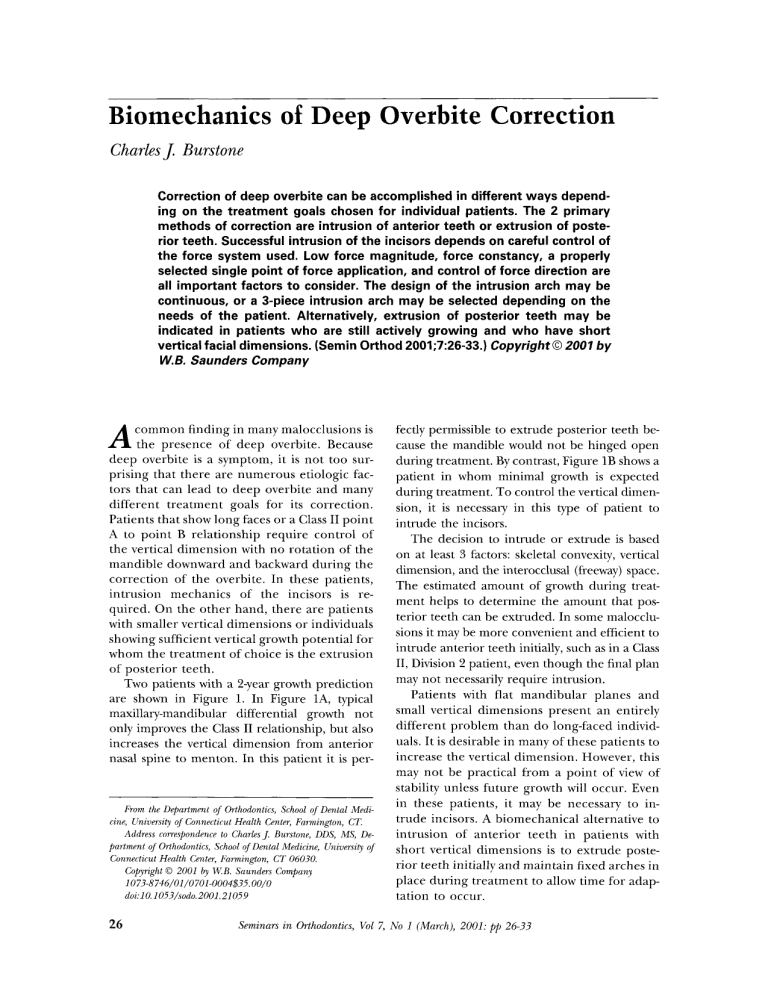
Biomechanics of Deep Overbite Correction Charles J. Burstone Correction of deep overbite can be accomplished in different ways depending on the treatment goals chosen for individual patients. The 2 primary methods of correction are intrusion of anterior teeth or extrusion of posterior teeth. Successful intrusion of the incisors depends on careful control of the force system used. Low force magnitude, force constancy, a properly selected single point of force application, and control of force direction are all important factors to consider. The design of the intrusion arch may be continuous, or a 3-piece intrusion arch may be selected depending on the needs of the patient. Alternatively, extrusion of posterior teeth may be indicated in patients who are still actively growing and who have short vertical facial dimensions. (Semin Orthod 2001;7:26-33.) Copyright© 2001 by W.B. Saunders Company A c o m m o n finding in m a n y malocclusions is the p r e s e n c e of d e e p overbite. Because d e e p overbite is a s y m p t o m , it is n o t too surprising that t h e r e are n u m e r o u s etiologic factors that can lead to d e e p overbite a n d m a n y d i f f e r e n t t r e a t m e n t goals for its c o r r e c t i o n . Patients that show l o n g faces or a Class II p o i n t A to p o i n t B r e l a t i o n s h i p r e q u i r e c o n t r o l of the vertical d i m e n s i o n with no r o t a t i o n of the m a n d i b l e d o w n w a r d a n d backward d u r i n g the c o r r e c t i o n of the overbite. In these patients, intrusion m e c h a n i c s of the incisors is required. O n the o t h e r h a n d , t h e r e are patients with smaller vertical d i m e n s i o n s or individuals showing sufficient vertical growth p o t e n t i a l for w h o m the t r e a t m e n t of choice is the e x t r u s i o n o f p o s t e r i o r teeth. Two patients with a 2-year growth prediction are shown in Figure 1. In Figure 1A, typical maxillary-mandibular differential growth not only improves the Class II relationship, but also increases the vertical dimension f r o m anterior nasal spine to m e n t o n . In this patient it is per- From the Department of Orthodontics, Sehool of Dental Medicine, University of Connecticut Health Center, Fa,vvnington, CT. Ad&~ss correspondence to CharlesJ. Burstone, DDS, MS, Department of Orthodontics, School of Dental Medicine, University of Connecticut Health Center; Farmington, CT 06030. Copyright © 2001 by W..B. Saunders Company 1073-8746/01/0701-0004535.00/0 doi:l O.1053/sodo. 2001.21059 26 fectly permissible to extrude posterior teeth because the mandible would not be hinged o p e n during treatment. By contrast, Figure 1B shows a patient in w h o m minimal growth is expected during treatment. To control the vertical dimension, it is necessary in this type of patient to intrude the incisors. T h e decision to intrude or extrude is based on at least 3 factors: skeletal convexity, vertical dimension, and the interocclusal (freeway) space. T h e estimated a m o u n t of growth during treatm e n t helps to d e t e r m i n e the a m o u n t that posterior teeth can be extruded. In some malocclusions it may be m o r e convenient and efficient to intrude anterior teeth initially, such as in a Class II, Division 2 patient, even t h o u g h the final plan may not necessarily require intrusion. Patients with fiat m a n d i b u l a r planes a n d small vertical d i m e n s i o n s p r e s e n t an entirely d i f f e r e n t p r o b l e m t h a n do long-faced individuals. It is desirable in m a n y o f these patients to increase the vertical d i m e n s i o n . However, this may n o t be practical f r o m a p o i n t of view of stability unless future growth will occur. Even in these patients, it may be necessary to int r u d e incisors. A b i o m e c h a n i c a l alternative to i n t r u s i o n of a n t e r i o r t e e t h in patients with short vertical d i m e n s i o n s is to e x t r u d e posterior teeth initially a n d m a i n t a i n fixed arches in place d u r i n g t r e a t m e n t to allow time for adaptation to occur. Seminars in Orthodontics, Vol 7, No 1 (March), 2001: cop 26-33 Biomechanics of Deep Overbite Correction I ~.S I t I "/ ¢"1 iS JI ' I ! .-T~ 1." ti , Growth Estimate 14 y r s . 16 y r s . 0 mos. --0 mos. -- 2 i, Figure 1. Growth influences the decision to intrude incisors. Two-year growth prediction shows the overbite corrected by growth. Posterior teeth can be erupted (A). Little growth in 2-year prediction. Incisor intrusion is needed (B). The biomechanics of 2 different types of deep overbite correction are discussed separately in this article. First, incisor intrusion, and second, extrusion mechanics for posterior teeth. Incisor Intrusion For many years it was believed that it was impossible to intrude teeth and that if intrusion was attempted, undesirable sequellae such as devital- 27 ization would occur. Early studies of treated patients saw little intrusion of incisors because the mechanics used tended to extrude posterior teeth. It has been shown that the use of light constant forces enables the intrusion of teeth with minimal disruption of posterior a n c h o r units. It has also been shown that as the forces for intrusion are increased, more root resorption but not necessarily a greater rate of intrusive m o v e m e n t may result. 1 Figure 2 shows a patient in whom intrusion was accomplished in both the u p p e r and lower arches using light constant forces. The u p p e r incisors c o m m o n l y must be intruded more than lower incisors to maintain the original cant of the plane of occlusion. This requires controlled mechanics because in the Class II patient, the application of Class H elastics or cervical headgear and other similar mechanisms can steepen the plane of occlusion and negate any intrusion effects. There are 2 basic designs to an intrusion arch: (1) a continuous arch, and (2) a 3-piece intrusion mechanism. 2-6 Both of these appliances are described in this section. The application of each is determined by the needs of the patient.7, 8 The continuous intrusion arch is shown in Figure 3. A relatively rigid anchorage unit connects the teeth of the posterior segment. The cuspid is bypassed by placing a small step in the region of the cuspid or eliminating the cuspid bracket entirely. Anterior teeth are connected together with an incisor segment. A 0.017 × 0.025-inch or 0.016 × 0.022-inch titanium molybdenum alloy (TMA) intrusion arch from an auxiliary tube places the intrusive force on the incisors. As the wire is b r o u g h t down to the central incisors or the lateral incisors, only single forces are directed in an intrusive direction. The key to successful intrusion is control of the force system. Specifically, force magnitude, constancy, the use of only a single-point application, control of the direction of force, and the selection of a p r o p e r point for the force application are carefully planned and delivered. Force magnitude can be determined either using tables or directly by a force gauge (Fig 4). Sometimes the clinician will neglect to measure the forces and only place a V b e n d posteriorly. This can be dangerous because arches vary in length and there is not a constant angulation for a desirable activation. If too m u c h force is ap- 28 Charles J. Bu,:,tone plied, undesirable side effects, including steepening of the occlusal plane or distal tipping of a molar, can occur, The magnitude of force depends on the n u m b e r of teeth and their size. For example, during intrusion of u p p e r incisors, about 60 g of force for 4 incisors are used. Figure 5 shows a patient with a continuous intrusion arch before and after intrusion. The use of low forces and a stable anchorage unit will not upset posterior anchorage and should maintain the original plane of occlusion. The force-deflection rate of the intrusion arch is very low, usually u n d e r 10 g / m m , because the distance is large between the auxiliary tube of the molar and the incisor brackets2 This not only produces a large deflection, minimizing the need for any reactivation, but also ensures greater constancy of force. It also enhances the accuracy of the appliance because any small error in activation produces a minimal change in the delivered force. A particularly important consideration in intrusion is to assure that the intrusion arch does not fit into the brackets of the incisors. Instead, a separate segment is placed. There are a nun> bet of reasons why it is not desirable to put either a rectangular or a r o u n d intrusion arch wire directly into an edgewise bracket anteriorly. The intrusive arch can change shape, p r o d u c i n g mesial displacement of the roots of incisors. Most importantly, any torque, labial or lingual, can alter the intrusive force (Fig 6). If purposely or accidentally placed lingual root torque is present, it could completely eliminate any intrusive force. At the other extreme, labial root torque may increase the intrusive force with a concomitant increase of extrusive force and tip back m o m e n t on the molar. Once an edgewise intrusion arch wire is placed into the anterior brackets, a precise mechanism is not present. The clinician should carefully look at the anatomic a r r a n g e m e n t of the teeth to determine which teeth require intrusion. The Class II, Division 2 patient may only need intrusion of 2 central incisors. Many Class II, Division 1 patients require intrusion of 4 incisors. These an- I i l'~ I # I I l ~.# l I I I J~ s ~ I #! \ Figure 2. Maxillary and mandibular intrusion using a continuous intrusion arch. Cranial base superimposition (A). Separate maxillary and mandibular superimpositions (B). II " lli~ Biomechanics of Deep Overbite Correction 29 Figure 3. Passive and active continuous intrusion arches. Separate posterior and anterior segments are placed. The canine is bypassed. Buccal view passive (A) and active (B). Frontal view passive (C) and active (D). a t o m i c discrepancies s h o u l d be eliminated by segmental intrusion r a t h e r than by indiscriminate leveling. If the patient initially has leveling wires placed in a full-arch wire, it t h e n almost b e c o m e s impossible to p r o d u c e effective intrusion o f the incisors. O n e o f the key aspects o f c o n t r o l l i n g the ~i~ !ii¸¸!iliii~i~/~!~ii~i:~i;~i~ t Figure 4. The force system. Measuring the force with a force gauge (A). The reactive force on the posterior anchorage unit produces potential extrusion and steepening of the occlusal plane (B). Figure 5. Upper incisor intrusion. Before (A) and after (B). Charles J. Burstone 30 A Figure 8. Frontal view of a 3-piece intrusion arch with hooks attached distal to the lateral incisors. Separate right and left springs apply intrusive force distal to the lateral incisors. B i!i!~ '~iiiii~ the l o n g axis o f the tooth. T h e i n c i s o r will readily i n t r u d e a n d n e i t h e r r e t r a c t n o r flare. W i t h a typical axial i n c l i n a t i o n , the force is labial to the c e n t e r of resistance so that the t o o t h will i n t r u d e b u t also have a m o m e n t t h a t w o u l d retract the r o o t p r o v i d e d the intrusive arch is tied back. For Class II, Division 2 patients, some lingual r o o t m o v e m e n t m a y be desirable. However, i n p a t i e n t s with a l r e a d y flared incisors, p l a c i n g a n intrusive force labial to the c e n t e r o f resist a n c e is m o r e p r o b l e m a t i c . T h e r o o t is p r o b a b l y Figure 6. Placing an arch wire in the incisor brackets alters the magnitude of the intrusive force. Lingual root torque produces extrusion (A). Labial root torque produces intrusion (B). force system d u r i n g i n t r u s i o n is to d i r e c t the force s o m e w h a t parallel to the l o n g axis o f the tooth. I n F i g u r e 7, 3 d i f f e r e n t axial i n c l i n a t i o n s of incisors are shown. W i t h a vertical incisor, a c o n t i n u o u s i n t r u s i o n arch c a n direct the force close to the c e n t e r o f resistance a n d parallel to Figure 7. An intrusive force labial to tile incisors produces different effects as axial inclinations vary. The intrusion force unfavorably moves the incisor root lingually in a flared incisor. Figure 9. Three-piece intrusion arch with chain elastic (A) or spring (B) redirects the force parallel to the long axis of the incisor. Biomechanics of Deep Overbite Correction 31 Figure 10. Cantilever with eyelet. The direction of the force is parallel to the ligature tie. Figure 12. Force can be positioned either anterior or posterior to the center of resistance of the incisor segment to produce intrusion-protrusion, pure intrusion, or intrusion-retraction. too far lingual to begin with, a n d f u r t h e r m o r e , the force is n o t d i r e c t e d a l o n g the l o n g axis o f the tooth. Consequently, there is a large labial c o m p o n e n t to the force. T h e t o o t h will n o t readily i n t r u d e a n d can flare further. It is in this type o f patient that the 3-piece intrusion arch is used. T h e 3-piece intrusion arch is similar to the c o n t i n u o u s arch in that it requires a stable anc h o r a g e unit for the posterior teeth a n d a separate a n t e r i o r segment. Instead o f a c o n t i n u o u s wire, separate tip back springs are applied o n the right a n d left sides (Fig 8). T h e b e n t h o o k shown in Figure 8 delivers an intrusive force distal to the brackets o f the lateral incisors. W h e n the force is directed at 90 ° to the occlusal plane, its p o i n t o f a t t a c h m e n t can t h e n be p l a c e d t h r o u g h the c e n t e r o f resistance o f the incisors so that n o flaring o f the teeth occurs. In addition to altering the p o i n t o f force application, with flared incisors it may be necessary to redirect the force. T h e r e are a n u m b e r o f possible m e t h o d s for c h a n g i n g the line o f action o f the force so that it is parallel to the l o n g axes o f the incisors. T h e intrusive force can be supp l e m e n t e d by a distal force f r o m a chain elastic or a coil spring. T h e resultant force can t h e n b e c o m e parallel to the l o n g axes o f the incisors (Fig 9). Two o t h e r m e t h o d s for redirecting the force involve using separate cantilever intrusive springs. T h e first is shown in Figure 10. T h e o r i e n t a t i o n o f the tie is parallel to the direction o f force. By s h o r t e n i n g the arm, the force can be directed m o r e distally. T h e s e c o n d very simple m e t h o d for redirecting the force is shown in Figure 12. A posterior e x t e n s i o n to the a n t e r i o r s e g m e n t is a n g l e d so that the force is n o w directed a l o n g the l o n g axes o f the teeth. This assumes n o friction a l o n g the a r c h wire so that the resulting force only acts at 90 ° to the posterior section o f the a n t e r i o r segment. B Figure 11. Angling the posterior extension redirects the force parallel to the incisor long axis (A). Intrusive force on posterior extension of the anterior segment is 90 ° to the occlusal plane (B). ~!~i!~ ii!~ ~ii............./iI! 32 Charles.]. Bu~stone Figure 13. Extrusive mechanics. Upper bite plate on precision lingual arch (A). Bite plate attached to the lower arch allows separated posterior teeth to be extruded with vertical elastics or allowed to erupt (B). By using either a continuous intrusion arch or a 3-piece mechanism, the orthodontist can alter not only the magnitude of the force, but also the position of the force with respect to the center of resistance (Fig 12). 1° Furthermore, for optimal results, it is necessary to orient the force so it approaches parallelism to the long axes of the incisors. The use of a single tbrce leads to a greater accuracy than that achieved when an arch wire is placed into the brackets of the incisors with a continuous arch or 2 × 4 mechanism. 11q4 Key to anchorage control is the maintenance of low-magnitude forces and the use of a rigid posterior segment. This includes a lingual or transpalatal arch to maintain posterior widths. Backup with occipital headgear may be considered. A posteriorly and intrusively directed force from the headgear acting anterior to the center of resistance of the molar segment produces a m o m e n t that minimizes any steepening of the occlusal plane. O f course, headgear should not be used to cover up mistakes in intrusion mechanics where force magnitudes are too great. Extrusion of Posterior Segments Figure 14. Vertical elastic applied to posterior teeth separated by a bite plate. Individual tooth extrusion (A). Segmental tooth extrusion (B). The extrusion of posterior teeth for the correction of deep overbite may be less d e m a n d i n g than intrusive mechanics but must still be accomplished carefully to avoid canting of the occlusal plane. Many continuous arches extrude teeth. More efficiently, a 3-piece tip back mechanism with increased forces to a large anterior segment can be used to tip back and extrude the posterior teeth. 15 To minimize any steepening of the u p p e r plane of occlusion with larger forces, cervical headgear with a long and high outer bow can p r o d u c e a m o m e n t to bring the u p p e r plane of occlusion vertically without a change of cant. An u p p e r bite plate attached to a precision lingual arch is a useful adjunct for posterior eruption with or without other mechanics (Fig Biomechanics of Deep Overbite Correction 13A). Unlike removable bite plates, the fixed appliance is not under the control of the patient, which enhances its efficiency. A lower bite plate from cuspid to cuspid can also be used to separate the posterior teeth, allowing for vertical extrusive mechanics to be expressed more easily (Fig 13B). With posterior teeth separated by either an upper or lower bite plate, vertical elastics can be u s e d either to an entire segment or to individual teeth, b e c a u s e often n o t all teeth have to be e r u p t e d equally (Fig 14). T h e p o s i t i o n o f the force as well as the n u m b e r o f teeth in the buccal s e g m e n t can be c o n t r o l l e d . Conclusion The correction of deep overbite requires careful differential diagnosis and the determination of which teeth must be intruded or extruded for proper correction. Therefore, the mechanics for treatment can differ radically from one patient t o a n o t h e r . T h e k e y t o s u c c e s s f u l c o r r e c t i o n is not only the proper treatment plan, but precise mechanics to achieve the predetermined treatment plan goals. References 1. Dellinger EL. A histologic and cephalometric investigation of premolar intrusion in the Macaca speciosa monkey. Am J Orthod 1967;53:325-355. 2. Burstone CJ. Rationale of the segmented arch. Am J Orthod 1962;48:805-822. 33 3. Burstone CJ. Mechanics of the segmented arch technique. Angle Orthod 1966;36:99-120. 4. Burstone CJ, van Steenberg E, Hanley KJ. Modern Edgewise Mechanics and the Segmented Arch. Ormco Press, 1995, pp 32-48. 5. Burstone CJ. Biomechanics of the orthodontic appliance, in Graber TM (ed): Current Orthodontic Concepts and Techniques. Philadelphia, PA, Saunders, 1969, pp 160-178. 6. Lindauer SJ, lsaacson RJ. One-couple orthodontic appliance systems. Semin Orthod 1995;1:12-24. 7. Burstone CJ. Biomechanical rationale of orthodontic therapy, in Melsen B (ed): Controversies in Orthodontics. Berlin, Germany, Quintessence, 1991, pp 131-146. 8. Burstone CJ. Deep overbite correction by intrusion. A m J Orthod 1977;72:1-22. 9. Burstone CJ, Baldwin JJ, Lawless DT. The application of continuous forces to orthodontics. Angle Orthod 1961; 31:1-14. 10. Shroff B, Lindauer SJ, Burstone CJ, et al. Segmented approach to simultaneous intrusion and space closure: Biomechanics of the three-piece base arch appliance. A m J Orthod Dentofac Orthop 1995;107:136-143. 11. Koenig HA, Burstone cJ. Force systems from an ideal arch: Large deflection considerations. Angle Orthod 1989;59:11-16. 12. Ronay F, Kleinert MW, Melsen B, Burstone CJ. Force system developed by V bends in an elastic orthodontic wire. A m J Orthod Dentofac Orthop 1989;96:295-301. 13. Burstone CJ, Koenig HA. Creative wire bending: The force system from step and V bends. AmJ Orthod Dentofac Orthop 1988;93:59-67. 14. Burstone CJ, Koenig HA. Force systems from an ideal arch. Am J Orthod 1974;65:270-289. 15. Romeo DA, Burstone CJ. Tip-back mechanics. Am J Orthod 1977;72:414-421.
